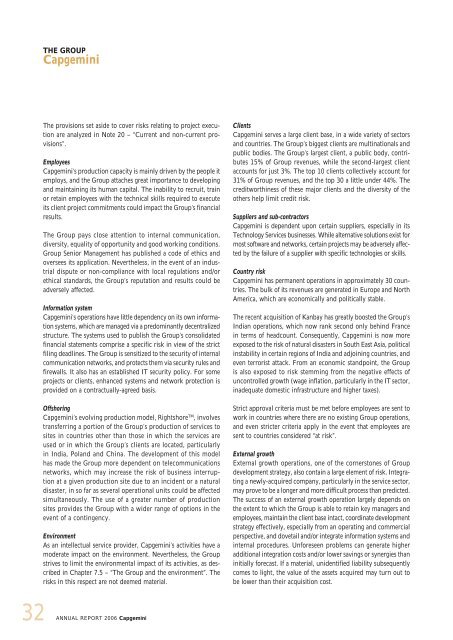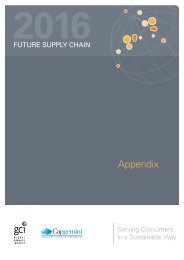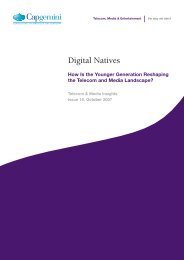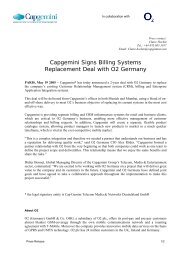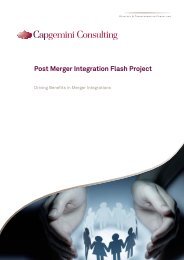You also want an ePaper? Increase the reach of your titles
YUMPU automatically turns print PDFs into web optimized ePapers that Google loves.
32 ANNUAL<br />
THE GROUP<br />
<strong>Capgemini</strong><br />
The provisions set aside to cover risks relating to project execution<br />
are analyzed in Note 20 – “Current and non-current provisions”.<br />
Employees<br />
<strong>Capgemini</strong>’s production capacity is mainly driven by the people it<br />
employs, and the Group attaches great importance to developing<br />
and maintaining its human capital. The inability to recruit, train<br />
or retain employees with the technical skills required to execute<br />
its client project commitments could impact the Group’s financial<br />
results.<br />
The Group pays close attention to internal communication,<br />
diversity, equality of opportunity and good working conditions.<br />
Group Senior Management has published a code of ethics and<br />
oversees its application. Nevertheless, in the event of an industrial<br />
dispute or non-compliance with local regulations and/or<br />
ethical standards, the Group’s reputation and results could be<br />
adversely affected.<br />
Information system<br />
<strong>Capgemini</strong>’s operations have little dependency on its own information<br />
systems, which are managed via a predominantly decentralized<br />
structure. The systems used to publish the Group’s consolidated<br />
financial statements comprise a specific risk in view of the strict<br />
filing deadlines. The Group is sensitized to the security of internal<br />
communication networks, and protects them via security rules and<br />
firewalls. It also has an established IT security policy. For some<br />
projects or clients, enhanced systems and network protection is<br />
provided on a contractually-agreed basis.<br />
Offshoring<br />
<strong>Capgemini</strong>’s evolving production model, Rightshore TM , involves<br />
transferring a portion of the Group’s production of services to<br />
sites in countries other than those in which the services are<br />
used or in which the Group’s clients are located, particularly<br />
in India, Poland and China. The development of this model<br />
has made the Group more dependent on telecommunications<br />
networks, which may increase the risk of business interruption<br />
at a given production site due to an incident or a natural<br />
disaster, in so far as several operational units could be affected<br />
simultaneously. The use of a greater number of production<br />
sites provides the Group with a wider range of options in the<br />
event of a contingency.<br />
Environment<br />
As an intellectual service provider, <strong>Capgemini</strong>’s activities have a<br />
moderate impact on the environment. Nevertheless, the Group<br />
strives to limit the environmental impact of its activities, as described<br />
in Chapter 7.5 – “The Group and the environment”. The<br />
risks in this respect are not deemed material.<br />
REPORT 2006 <strong>Capgemini</strong><br />
Clients<br />
<strong>Capgemini</strong> serves a large client base, in a wide variety of sectors<br />
and countries. The Group’s biggest clients are multinationals and<br />
public bodies. The Group’s largest client, a public body, contributes<br />
15% of Group revenues, while the second-largest client<br />
accounts for just 3%. The top 10 clients collectively account for<br />
31% of Group revenues, and the top 30 a little under 44%. The<br />
creditworthiness of these major clients and the diversity of the<br />
others help limit credit risk.<br />
Suppliers and sub-contractors<br />
<strong>Capgemini</strong> is dependent upon certain suppliers, especially in its<br />
Technology Services businesses. While alternative solutions exist for<br />
most software and networks, certain projects may be adversely affected<br />
by the failure of a supplier with specific technologies or skills.<br />
Country risk<br />
<strong>Capgemini</strong> has permanent operations in approximately 30 countries.<br />
The bulk of its revenues are generated in Europe and North<br />
America, which are economically and politically stable.<br />
The recent acquisition of Kanbay has greatly boosted the Group’s<br />
Indian operations, which now rank second only behind France<br />
in terms of headcount. Consequently, <strong>Capgemini</strong> is now more<br />
exposed to the risk of natural disasters in South East Asia, political<br />
instability in certain regions of India and adjoining countries, and<br />
even terrorist attack. From an economic standpoint, the Group<br />
is also exposed to risk stemming from the negative effects of<br />
uncontrolled growth (wage inflation, particularly in the IT sector,<br />
inadequate domestic infrastructure and higher taxes).<br />
Strict approval criteria must be met before employees are sent to<br />
work in countries where there are no existing Group operations,<br />
and even stricter criteria apply in the event that employees are<br />
sent to countries considered “at risk”.<br />
External growth<br />
External growth operations, one of the cornerstones of Group<br />
development strategy, also contain a large element of risk. Integrating<br />
a newly-acquired company, particularly in the service sector,<br />
may prove to be a longer and more difficult process than predicted.<br />
The success of an external growth operation largely depends on<br />
the extent to which the Group is able to retain key managers and<br />
employees, maintain the client base intact, coordinate development<br />
strategy effectively, especially from an operating and commercial<br />
perspective, and dovetail and/or integrate information systems and<br />
internal procedures. Unforeseen problems can generate higher<br />
additional integration costs and/or lower savings or synergies than<br />
initially forecast. If a material, unidentified liability subsequently<br />
comes to light, the value of the assets acquired may turn out to<br />
be lower than their acquisition cost.


